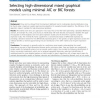301 search results - page 26 / 61 » Kronecker Graphs: An Approach to Modeling Networks |
SIGECOM
2006
ACM
14 years 2 months ago
2006
ACM
Braess’s Paradox is the counterintuitive but well-known fact that removing edges from a network with “selfish routing” can decrease the latency incurred by traffic in an eq...
BMCBI
2010
13 years 8 months ago
2010
Background: Chow and Liu showed that the maximum likelihood tree for multivariate discrete distributions may be found using a maximum weight spanning tree algorithm, for example K...
IJCNN
2007
IEEE
14 years 3 months ago
2007
IEEE
— The assessment of highly-risky situations at road intersections have been recently revealed as an important research topic within the context of the automotive industry. In thi...
RECOMB
2010
Springer
14 years 3 months ago
2010
Springer
Constructing quantitative dynamic models of signaling pathways is an important task for computational systems biology. Pathway model construction is often an inherently incremental...
CORR
2012
Springer
12 years 4 months ago
2012
Springer
Graphs and networks are used to model interactions in a variety of contexts, and there is a growing need to be able to quickly assess the qualities of a graph in order to understa...


